John had told us he wanted to go to the beach every day. So, first thing this morning we went over to Pigeon Beach. It is the closest beach to us, located on the peninsula that separates Falmouth from English Harbors. There is a walking trail from Nelson’s Dock Yard to Pigeon Beach, but we were lazy and drove. Even though it is a short distance as the crow flies, the road to get there is hilly and windy and was actually a surprisingly long drive.
The beach is absolutely lovely, with white sand and big, shady trees growing out of the sand. There are picturesque views of Falmouth Harbor to the right, the ocean to the left, and directly across the way, verdant hills. It is actually fairly small, and there is a picnic table under a palapa (small thatched roof). A few houses dot the landscape on both sides, some quite expensive looking, but the scenery is mostly untouched, green land. There were only four other people on the beach, so we had it pretty much to ourselves.
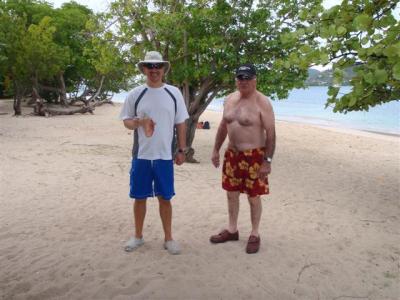
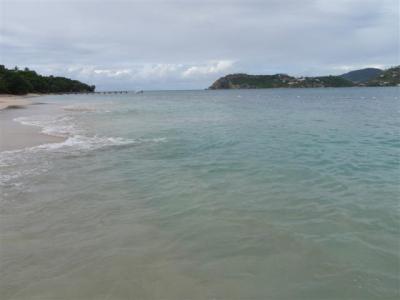
After about an hour, we went back to Kosmos to clean up, then set off to go sightseeing. Our first destination was the Shirley Heights historical monument, which has more to it than just the bar we had gone to the other night. The roads aren’t very well marked, and we made a few wrong turns, but eventually we found the road up to the park. There were several large herds of goats walking around in the hills.
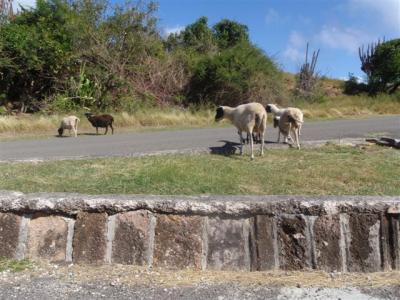
Shortly beyond the park entrance is the visitor’s center, which looks like it is probably another restored historic building made of white brick with quaint blue shutters. We were herded into a small tour group. The guide walked us out to a brick structure on a small hill behind the visitor’s center. The structure was probably a look out post back in the day, and from the upper level we had fabulous 360 views of the island.
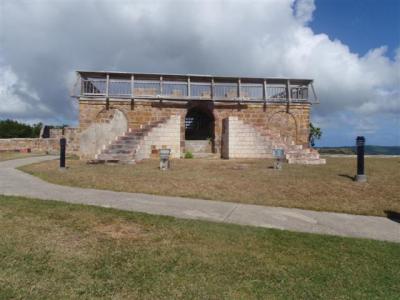
The guide pointed to all the different historical sites within our view and told us about them, both inland and on the water. Something we hadn’t already known was that the Arawaks had lived in English Harbor, among other places on the island. Another thing we didn’t know was that the English had set up a chain blockade at the entrance to English Harbor. It laid on the ground under the water. When the lookouts in Shirley Heights saw French ships on the horizon, they would signal the soldiers below using a flag system. Dozens and dozens of men on both sides of the entrance would pull up the barricade so that the French ships couldn’t get in. The signal system was used for communication between all the ships and bases. Via relays stations, forts and ships could communicate with one another even if they were on the other side of the island. By day they used a complex assortment of flags, with each flag sending a specific message. After dark they used gunshots and lanterns for the signals.
A main reason this location was so perfect was because on clear days they could see the French island of Guadeloupe from here, so they could keep a close eye on the French. The big downside to building here was that there was no natural source of water, so the military set up a water collection system that fed into a cistern. Here is a shot of English Harbor. We put it in because you can see Nelson’s Dockyard clearly, which you couldn’t see at all in the picture we had we posted a few days ago.
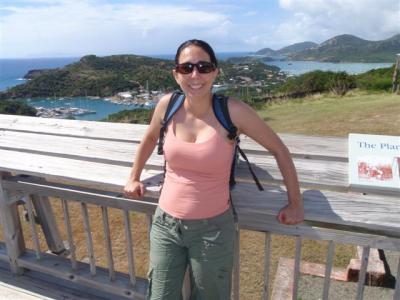
From there we went inside the visitor’s center. One room was a small museum with an eclectic collection of odds and ends, from sea shells to modern Antiguan icons. The second room featured a multi-media presentation on the history of Antigua. It only lasted a few minutes. The narrator had a heavy accent that we found hard to understand, but we did get that the history had been seriously white washed.
We hopped back in the car and went farther up the road. It led to the restaurant/bar we had been to the other night. It was originally built in 1791 as a guard house, kitchen and magazine (storage facility). Another building seems to be actively being rebuilt near the guard house. We took John around back to show him the awesome views.

Then we moved on to the last section of the base, located on the next cliff over from the restaurant. The views are also stunning from here, overlooking Indian Creek and Willoughby Bay to the east of English Harbor. The snaking one in the foreground is Indian Creek and the brighter blue one in the background is Willoughby Bay. The cruising guide had said that while Willoughby Bay looks like an ideal anchorage, it is shallow and many a boat has sunk there.
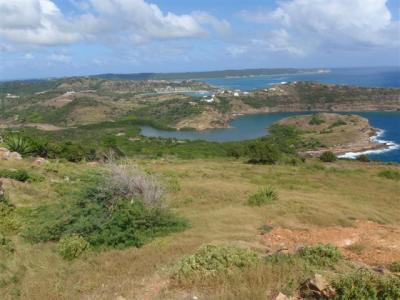
There are a few shells of buildings left, and there was a work crew actively working on a building foundation so they could reconstruct it. It was a hot day and we felt sorry for the guys doing manual labor in the heat.

Once we were done at Shirley Heights, we stopped at a little stand for lunch, definitely the kind of place geared at locals, not tourists. We all ordered curried chicken rotis, which are like an Indian version of a burrito. It was potatoes and pieces of chicken covered with a curry sauce and served wrapped in a tortilla-like piece of bread. The sauce was also bland, so bland must be how they prefer it on Antigua. Curry is popular here and we have seen it on many menus.
The next destination was Jolly Harbor, located almost halfway up the west coast of the island. We followed the main road out of English Harbor that cuts through the middle of the island, but this time we turned west at Fig Tree Drive. Fig Tree Drive is a five mile stretch of road through the island’s only rainforest. The foliage is definitely thicker here, with lots of banana, mango and coconut trees. The trees all look like they grow wild, and there is little development. It is an especially pretty spot, particularly when you get a glimpse of the ocean through the rainforest.
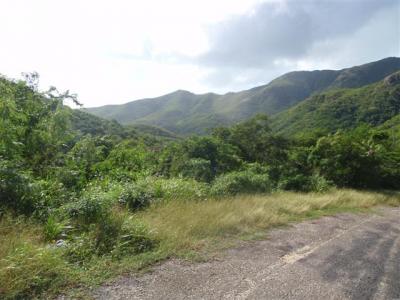
Fig Tree Drive ends at the southwest corner of the island, and from there the road turns north and parallels the shoreline. The landscape goes back to being much the same as what we saw yesterday, except, of course, there are stunning ocean views and we passed a few gorgeous looking beaches. At one point we saw some cows and mentioned that the little white birds seem to live harmoniously alongside the cows. John says he saw in a documentary that the birds eat the cow droppings, which is why the birds follow the cows around. Interesting.
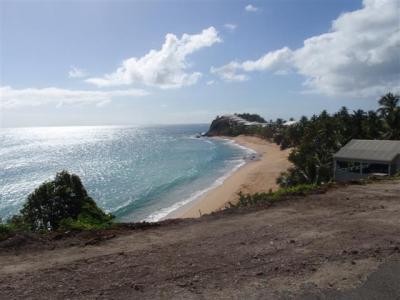
We had heard Jolly Harbor was nice, but we thought it was pretty unexciting. It is your typical marina development docks and a marina center with several restaurants, yacht brokers, and the like. The docks are only half full. It is surrounded by a few hotels and track housing on man made cays. There are many houses still under construction and many vacant lots that are waiting to be built on. The most interesting part of the complex is a fancy casino building, but it recently went out of business so we couldn’t go inside. We got a sense that they had tried to make this very upscale, but something was lacking that made it feel not as nice as they were shooting for. We couldn’t put our finger on exactly what it was. Here is the casino in the background.
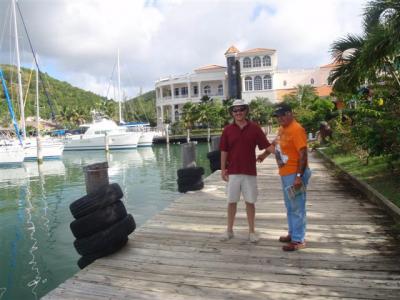
After spending quite a bit of time exploring the complex, we headed back to English Harbor and went to dinner at one of the restaurants in St. Helena’s. Here is a shot of Kosmos docked in Nelson’s Dockyard. The building on the left was constructed in 1789. The bottom floor was the Copper and Lumber store. The upstairs were temporary quarters for sailors who couldn’t stay on board while work was being done to their boats. Today it is a restaurant and hotel.

St. Helena’s is a one minute ride by dinghy from Nelson’s, but quite a long drive by car. When we arrived at the restaurant, we realized we had forgotten to pack bug spray. If we were in the dinghy, we would have buzzed over and picked some up right then, but since it was a long drive we decided to live without it. That was a mistake. Eric was literally eaten alive. No exaggeration, he walked out of there with 70 bug bites on his body.
As a side note, we have eaten at enough restaurants now to say that the food in Antigua is expensive, the portions are small, and the food is ordinary. The food isn’t bad, just not anything special. We didn’t mind the high prices in Guadeloupe, where the portions were huge and the food was exceptional. But on Antigua, the food is just not a good value for the dollar.
[008]
